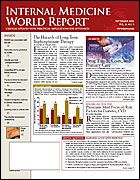Publication
Article
Internal Medicine World Report
HIV Treatment Guidelines Updated
Author(s):
Keeping Pace with Clinical Advances
The year 2006 marks 2 notable AIDS-related anniversaries; it has been 25 years since the first reports of AIDS, and it has been 10 years since the introduction of highly active antiretroviral therapy (HAART) for HIV infection. A better understanding of the disease, its transmission, and resistance to antiretroviral drugs has led to the development of many new drugs that have simplified treatment and have changed the prognosis for patients from a sure death sentence to a life with chronic disease.
JAMA
The International AIDS Society—USA Panel reviewed data released between mid-2004 and May 2006 and has issued state-of-the-art treatment recommendations for physicians (. 2006; 296:827-843).
Initial Therapy, Follow-Up
Treat all patients with symptomatic HIV infection with antiretroviral therapy. In asymptomatic patients, consider therapy when their CD4 cell count is between 350/μL and 200/μL; therapy is recommended for all those with a cell count ≤200/μL.
The decision to start therapy should be individualized according to the readiness of the patient, the rate of the reduction in the CD4 cell count, and plasma HIV-1 RNA level. Patients who once bristled at the idea of early treatment may now be swayed by the availability of newer, better-tolerated drug formulations and combinations.
Initial therapy consists of a regimen that includes either non—nucleoside reverse transcriptase inhibitor (NNRTI)- or protease inhibitor (PI)-based combinations. An NNRTI or a PI is typically combined with 2 nucleoside/nucleotide reverse transcriptase inhibitors (nRTIs) (Table). Triple nRTI regimens are not as effective and should not be used unless there is a high risk of toxicity, drug—drug interactions, or patient nonadherence.
Frequent measurement (ie, every 4-8 weeks) of plasma HIV-1 RNA and CD4 cell count is recommended. When the HIV-1 RNA level can no longer be detected by assay, regular determinations (eg, 3-4 times annually) of HIV-1 RNA level and CD4 cell count are recommended.
Test patients for HIV resistance at baseline if there is a >5% prevalence of transmitted HIV drug resistance. Also consider testing when the prevalence is unknown but transmission of drug resistance is likely because of high antiretroviral penetration in the community. Genotypic testing should be used to determine resistance, not phenotypic testing, because the former is faster, more readily available, and costs less.
Changing Therapy
Low-grade, transient symptoms are common in the first few weeks of therapy and can usually be managed with patient education and symptomatic treatment. If after an appropriate initial duration of therapy, the patient does not tolerate the drug regimen and 1 drug can be identified as the culprit, single-drug substitution is recommended. If no drug can be singled out and the toxic effect is severe, the entire regimen should be stopped and replaced.
Treatment failure is when HIV-1 RNA levels do not decrease to <50 copies/mL, the CD4 count declines, or HIV-related disease progresses. In such cases select at least 2, but preferably 3, new drugs that are likely to be active, based on the patient’s resistance test results and history of antiretroviral drug use.
Finally, the use of treatment interruptions is only recommended for patients who have significant toxic effects, develop an infection requiring treatment that may result in significant drug interactions, or insists on stopping treatment temporarily (ie, “treatment fatigue”).






